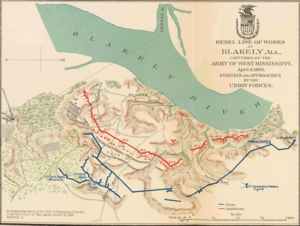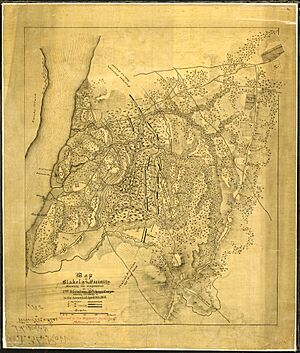Battle of Fort Blakeley facts for kids
Quick facts for kids Battle of Fort Blakeley |
|||||||
|---|---|---|---|---|---|---|---|
| Part of the American Civil War | |||||||
 Storming of Fort Blakeley |
|||||||
|
|||||||
| Belligerents | |||||||
| Commanders and leaders | |||||||
| Edward Canby Frederick Steele |
St. John R. Liddell | ||||||
| Units involved | |||||||
| Army of West Mississippi, Union ships |
Fort Blakeley Garrison, Confederate ships |
||||||
| Strength | |||||||
| 45,000 | 4,000 | ||||||
| Casualties and losses | |||||||
| 629 on April 9 (150 killed, 650 wounded total) | 2,900 (75 killed) | ||||||
The Battle of Fort Blakeley was an important fight during the American Civil War. It happened from April 2 to April 9, 1865, in Baldwin County, Alabama. This battle was part of a bigger plan to capture Mobile, Alabama, which was a key port for the Confederacy.
This battle was one of the very last major fights of the Civil War. It ended just hours after General Robert E. Lee surrendered to General Ulysses S. Grant at Appomattox. Mobile was the last big Confederate port to be taken by the Union forces.
Contents
How the Battle Unfolded
Union forces, led by Major General Edward Canby, moved along the eastern side of Mobile Bay. They pushed the Confederate soldiers back into their forts. The main targets were Spanish Fort, Alabama and nearby Fort Blakeley.
The Siege Begins
By April 1, Union soldiers had surrounded Spanish Fort. This allowed more troops to focus on Fort Blakeley. The Union army built three lines of earthworks, which are like dirt walls for protection. These lines got closer and closer to Fort Blakeley.
Confederate Brigadier General St. John Richardson Liddell defended Fort Blakeley with about 4,000 men. They faced a much larger Union army. Spanish Fort fell on April 8, which meant General Canby could send even more soldiers to attack Fort Blakeley.
The Final Attack
On April 9, 16,000 Union soldiers, led by Brigadier General John Parker Hawkins, launched their attack. The Union army had so many soldiers that they broke through the Confederate defenses. The Confederates, including General Liddell, had to surrender within about 30 minutes. This final attack happened after 5:30 PM.
Battle Outcomes and Numbers
About 75 Confederate soldiers were killed, and over 2,800 were captured. The Union army lost about 150 soldiers, and 650 were wounded. This battle was one of the last big fights involving both land and sea forces in the war.
Interestingly, this battle happened hours after General Robert E. Lee surrendered. This means the Civil War was almost over. African-American soldiers played a very important part in the Union victory. About 5,000 African-American troops from the U.S.C.T. helped in the attack.
Two days after the battle, the nearby island forts were left empty. After Fort Blakeley was captured, Union forces finally took control of Mobile, Alabama on April 12, 1865.
Fort Blakeley Today
The place where the battle happened is now a historical park called Historic Blakeley State Park. Groups like the American Battlefield Trust work to protect this important historical land. They have saved many acres of the battlefield.
See also
In Spanish: Batalla de Fort Blakely para niños



